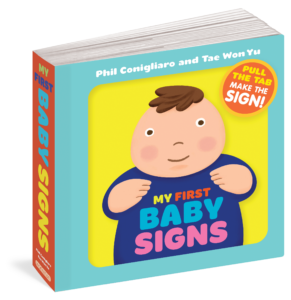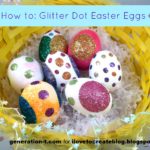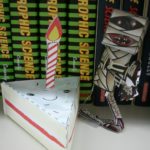Co-authors Phil Conigliaro and Tae Won Yu have worked together on many projects as artists. Putting their talent together, they created My First Baby Signs, a pop-up book designed to help babies learn essential words to communicate their needs. Justin Krasner, our associate editor of children’s books, had the chance to chat with Phil and Tae about their inspiration for the book, their artistic space, and what signs they would use to describe each other.
Justin Krasner: Hey, guys! Congrats on the gorgeous new book. In recent years, baby signing has gone from a hot trend to a well-established practice, bridging the gap between baby talk and first English words. Your book uses the ingenious addition of pull-tabs to show parents and babies exactly how to make each sign. How’d you come up with the concept?
Tae: I first encountered a baby using sign language when my friend brought her 8-month-old daughter to meet everyone. The baby was already communicating with her mom using signs and it was really remarkable to watch. They had this special bond that was based on a secret language just between the two of them. The mom could ask questions and the baby could tell her what she wanted or how she was feeling. Ever since then I’ve been curious about sign language for babies and thought it was a great way to foster a closer relationship between babies and their caretakers, as well as promote early development of language faculties and self expression.
JK: You two have been working together in the Art Cave designing Workman children’s books for other authors and illustrators for a while now, but this is your first collaboration on a book of your own—Wait! Before I go any further, will you describe exactly what the “Art Cave” is?
Tae: The Art Cave is our very messy laboratory/office at Workman where the principal designers for the children’s book group spend our days dreaming, kvetching, and making. I share the Cave with Colleen AF Venable, the art director and Phil. In addition to the usual art studio and design tools we have 2 (!) 3-D printers running constantly making prototypes for future books. We do get a lot of work done, but we spend just as much time just thinking up ridiculous ideas and sharing cool stuff we’ve seen and done.
Phil: Ooooh yes the Art Cave: A poorly lit (though voluntarily so) hole in the wall (that happens to also have a door) and hollowed out space (some might call it a room or an office). Though it is a humble space, it is full of doodads and whats-its to keep all the creative juices flowing. It’s a collaborative space with some of the sweetest and talented people I know.
JK: You’re both artists who enjoy working with paper. Phil, you’re the author of Colossal Paper Machines and Tae, your paper sculptures have appeared in magazines and on album covers. Do you remember when you first caught the paper crafting bug?
Phil: It was in the long ago time of 2011. I was approached by a wise sage who said, “You make things. Can you make a pop up book?” I shrugged and said “Sure. Why not?” I then took the book manuscript home for the weekend and tirelessly taught myself how to fold and cut paper.
Tae: I’ve been making paper costumes and robots since I was in kindergarten—literally Batman utility belts made out of taped-together construction paper and paper superhero outfits taped to my clothes. Actually, it was a few years back when I spent months working on the Recycled Robots book that I was reminded of how instinctively I could express myself using paper. But now that I have more tools and skills than I did when I was 5, I found that the joy was the same, but my vision was much more ambitious.
JK: Any gnarly paper cut accidents you’d like to share?
Phil: On my left thumb I have a set of matching scars each received a year apart.
Tae: It only takes 1 or 10 trips to the emergency room to make sure you are very careful, all the time. Always know where your knife is and where your fingers are; they are not meant to run into each other.
JK: Okay, last question: There are eight essential signs in the book. If you could choose one that reminds you of your co-author, what would it be?
Phil: The “more” sign makes me think the most of Tae. Whenever we work on projects together, he always wants more out of me, and by god does he get it! At any given time I’m probably thinking “ugh,” but I can never ever argue with the results. So, I hope the “mores” keep coming.
Tae: “Bath,” because Phil smells. “More,” because Phil gets what he wants. “All Done,” because Phil gets it done (eventually).
 About the Book:
About the Book:
At six months or so baby knows what she wants, but just can’t say it yet. Until now. Simple sign language is a proven bridge between baby talk and first English, and here’s the clearest way to learn it. With pull tabs that demonstrate exactly how to make each sign, My First Baby Signs teaches parents and babies eight essential words: “all done,” “milk,” “eat,” “more,” “thank you,” “bath,” “help,” and “bed.” Just pull the tab, point to the moving sign, and say the word. Your baby will be signing in no time.
Order the Book
Indiebound | B&N | Amazon | Workman





No Comments